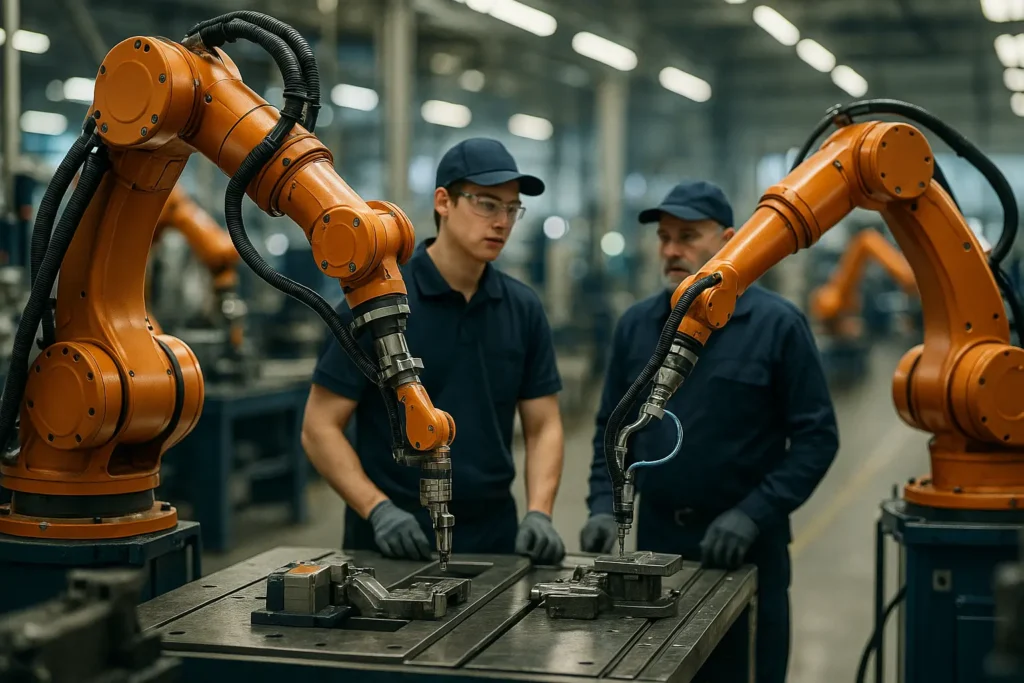As technology strides forward at an unprecedented pace, a question lingers in the mind of many: can the rise of artificial intelligence replace human workers on the factory floor? The landscape of manufacturing is evolving, shaped by robotic systems, advanced automation, and AI agents. As we explore the practicalities, benefits, and challenges of this transition, we must consider not only the potential for increased efficiency and production but also the human element. In this modern journalistic examination, we dive into the heart of the industry to understand what the future holds for both robots and humans working side by side.
The Role of Robotics in Modern Manufacturing
In the realm of manufacturing, robots have become synonymous with precision and productivity. Robotic systems are designed to perform repetitive tasks with unwavering accuracy, taking on roles that would be too monotonous or hazardous for humans. Yet, the integration of robotics into manufacturing is more than just a push for efficiency—it’s a strategic move towards a future where humans and robots collaborate.
Human workers remain crucial in this transition, as they bring adaptability and problem-solving skills that robots cannot yet replicate. In many factories, machines are designed to complement human tasks, reducing the physical workload and allowing us to focus on tasks that require critical thinking and creativity. As these systems evolve, our roles transform, shifting from manual labor to overseeing and managing these intelligent systems.
But the journey isn’t without hurdles. The implementation of robotics requires significant investment in design, production, and training. Workers must adapt to new roles, learning to interact with these sophisticated machines. Nevertheless, the potential benefits, from increased production speed to higher quality products, promise a rewarding return on investment for both companies and their workforce.
Automation: A Double-Edged Sword?
As we delve deeper into the world of automation, it becomes evident that its impact on the workforce is multifaceted. On one hand, automation offers unparalleled efficiency, increasing production rates while minimizing errors. Yet, on the other hand, it raises concerns about job displacement, with many fearing that machines might one day render human workers obsolete.
However, it’s essential to recognize that automation isn’t about replacing humans but rather redefining their roles. It allows workers to move away from tedious, time-consuming tasks and focus on areas that necessitate a human touch. As industries adopt advanced model systems, we find a shift in the job market—towards roles that require analytical skills, creativity, and systems management.
Moreover, automation agents handle vast amounts of data, offering insights that lead to smarter decision-making processes. As we embrace these advancements, it’s crucial to equip the workforce with the skills necessary to thrive in this new environment. Education and training programs become pivotal in ensuring that workers can transition smoothly into roles that are both fulfilling and integral to the industry’s success.
The Reality of Human-Robot Collaboration
Our vision of a harmonious work environment where humans and robots collaborate seamlessly is becoming a reality. As technology advances, we’ve witnessed remarkable strides in developing robots that are not only efficient but also intuitive. These systems excel in tasks that require precision, such as manufacturing intricate components or assembling products with minute details.
However, the real magic happens when human intelligence complements robotic precision. We find ourselves in an era where work is no longer about choosing between humans and robots but rather leveraging the strengths of both. For instance, robots can handle labor-intensive tasks, while humans focus on quality assurance and problem-solving. This collaboration enhances productivity, reduces fatigue, and fosters an environment where humans and machines learn from each other.
Yet, to make this relationship fruitful, design plays a crucial role. Robotics systems must be user-friendly, intuitive, and adaptable to human interaction. Companies must invest in creating workplaces that facilitate this collaboration, ensuring that both human and robot workers feel valued and equipped for success.
Conclusion: A Symbiotic Future
In conclusion, the question isn’t whether AI will replace humans on the factory floor, but rather how we can harness this technology to create a symbiotic future. As we’ve explored, the integration of robots and automation in industry doesn’t spell the end for human workers. Instead, it marks the beginning of a new chapter where human ingenuity and robotic efficiency coalesce to drive progress.
By embracing this modern approach, we can foster an environment where humans are not mere cogs in the machine but vital contributors to innovation and growth. As we prepare for this future, let us prioritize education, training, and design that supports and uplifts the workforce, ensuring that everyone has a seat at the table in this evolving system. The path ahead may be challenging, but with collaboration and vision, we can navigate the automation landscape, ensuring that it benefits both humans and machines alike.
FAQ
What are the current capabilities of AI in manufacturing?
AI in manufacturing can automate repetitive tasks, enhance precision in quality control, predict equipment maintenance needs, and optimize production schedules. However, it still requires human oversight for complex decision-making and handling unforeseen challenges.
Can AI completely replace human workers in factories?
While AI can automate certain tasks, it cannot entirely replace human workers. Human skills such as creativity, problem-solving, and adaptability remain crucial for tasks that require nuanced judgment and intricate decision-making.
How does AI impact job roles on the factory floor?
AI tends to shift the nature of job roles rather than eliminate them. Workers might transition from performing repetitive tasks to overseeing AI systems, ensuring machine efficiency, and focusing on tasks that require human intuition and experience.
What are the limitations of AI in a factory setting?
AI systems can struggle with tasks requiring emotional intelligence, complex judgment, and adaptability to unpredictable situations. They also need constant updates and maintenance to function effectively, which requires human intervention.
How can workers adapt to the rise of AI in manufacturing?
Workers can adapt by gaining new skills focused on AI system management, troubleshooting, and maintenance. Continuous learning and upskilling in technology-related areas are essential to stay updated with evolving manufacturing technologies.



